We Take The Porsche 911 Dakar For A Day At The Track
You couldn’t miss it if you tried. Its lifted stance, widened fenders, and Fuchs-style five-spoke wheels make the Porsche 911 Dakar instantly recognizable. Adorn it with one of a handful of available liveries, and this limited production model, which began its development as a Carrera 4 GTS, makes an even stronger case for why you should shell out the $223,450 it demands.
Not that you could, though, even if you had the cash. With production restricted to just 2,500 units, the entire lot has long since sold. Meanwhile, peering at pre-owned values reveals asking prices well north of $300,000. As is typical of Porsche’s limited-run models, it’s likely already sold out by the time you’ve heard of it.
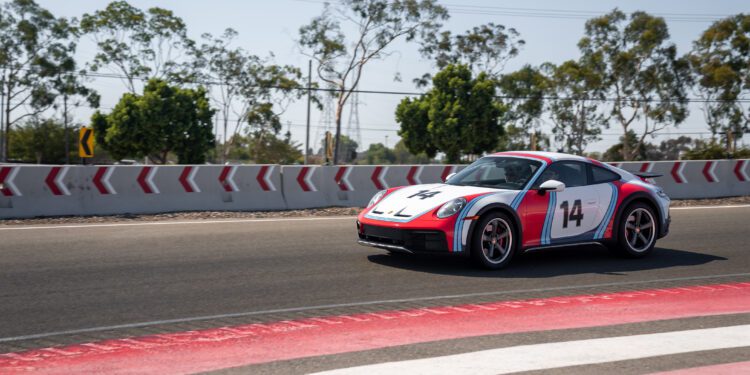
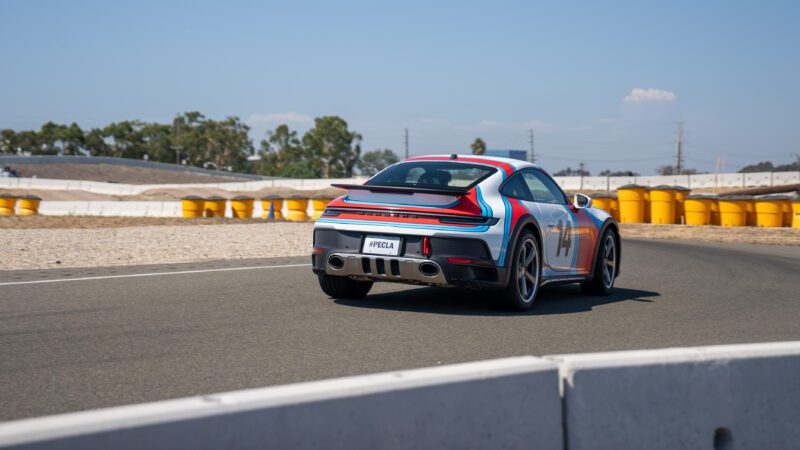
Why bother driving it then, you ask. The Dakar’s persona, like much of the 911 range, is multifaceted. While its marketing materials see it photographed in desolate places or tackling sandy dunes, the reality is that most will be stashed in collections by speculators or relegated to a life of pounding asphalt. Like the Lamborghini Huracan Sterrato, only a handful will ever be driven as intended. And so, its engineers haven’t built it to be an uncompromising off-roader. This is still a 911, after all, one that promises to be just as good on the trails as off them.
I’ll admit I’m pushing it to the other extreme here. When Porsche floated the idea of driving the Dakar for the first time at its Experience Center in Los Angeles rather than on the street or a carefully selected off-road course, I jumped at the opportunity. There’s a method to the madness, however. During the LA Auto Show in 2022, as I stood at a media preview for the Dakar, the carmaker sneakily mentioned that it’s as quick around the Nurburgring as a 996-generation 911 GT3, a fact that’s stuck with me since.
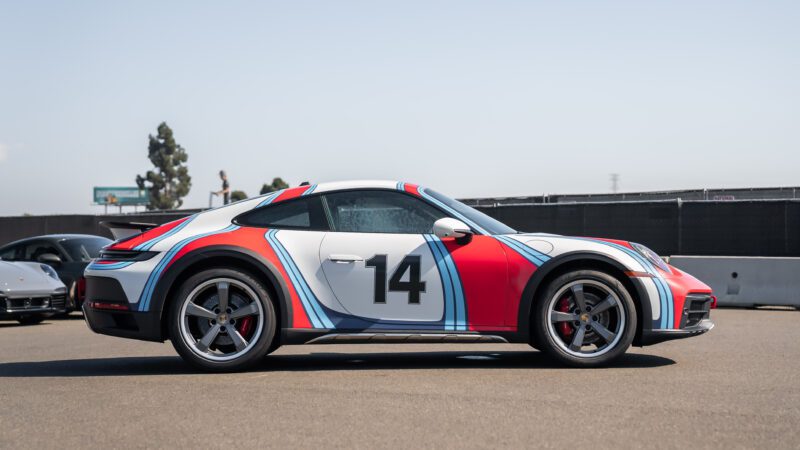
The Porsche Experience Center is an expansive facility in Carson, CA, less than 20 minutes from Los Angeles International Airport. It’s one of two PECs in the US; the first opened in Atlanta, Georgia, the home of the carmaker’s North American headquarters. In LA, the marque offers a driving experience in nearly every car it makes, ranging from a Cayenne S to the latest GT3 RS. Today, however, I’m here for the 90-minute session in the Dakar, an experience that’ll set you back $1,025.
Once checked in, you step past rows of preserved classics, a world-class workshop, a small cafe, and a full restaurant that makes up much of the building’s second floor. There’s plenty to do and even more to look at. Still, I was eager to get behind the wheel, so after a quick coffee, I met with the driving coach who would ride shotgun for the experience and stepped out to the PEC’s staging area.
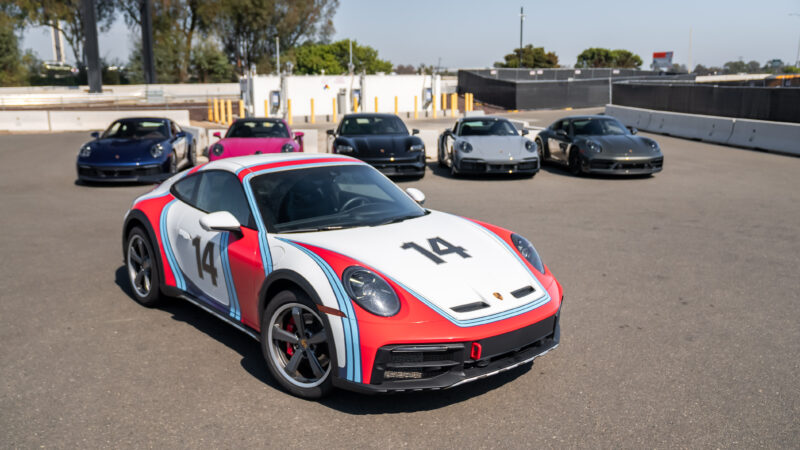
The Porsche 911 Dakar I’d be driving sat amongst a row of 718 Caymans, 911s, and Tacans of all flavors, wearing an optional Rally 1978 livery, a nod to the 911 SC Group 4 car Björn Waldegård drove in the East African Safari Rally that year. It sports a slick top devoid of a sunroof or any of the dozens of accessories available for it. Crucially for a day on the track, the staff at PEC had wrapped its five-spoke wheels with Pirelli P Zero summer tires.
While I understand the reasoning behind the decision to shelve its standard Pirelli Scorpion All Terrain Plus rubber, I was slightly disappointed. After all, Porsche developed the Dakar to be an off-roader first. While its options list does offer sets of summers and winters as extras, I wondered how much of its driving experience would now mirror that of the Carrera 4 GTS upon which it’s based. I sunk into its standard carbon fiber bucket seat fired up its flat-six and slowly crept onto the track.
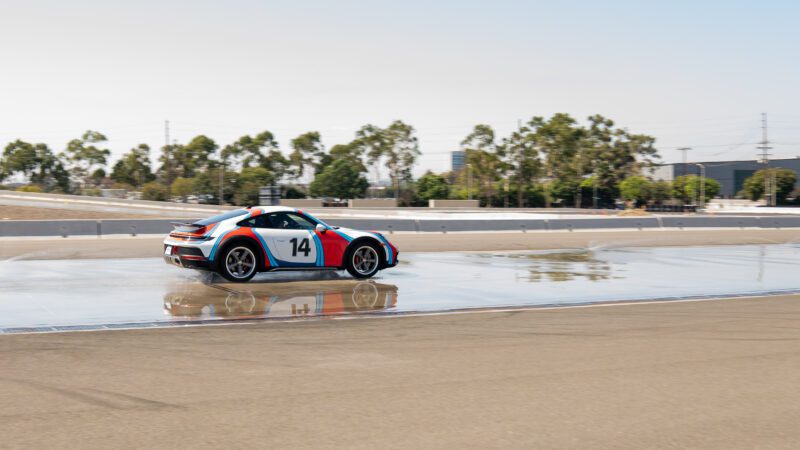
The Porsche 911 Dakar experience may only be 90 minutes long but has a choose-your-own-adventure feel. The crown jewel of the PEC is its 1.3-mile handling circuit. However, there are low-friction courses, a giant skidpad equipped with sprinklers to ensure you’re instantly sideways, a kick plat exercise to test your reaction times, and an off-road circuit. The latter is reserved for SUVs, so this is purely a track day.
We kicked off with a few runs on the kick plate, which, as its name suggests, uses a shifting metal panel that swings a car’s rear randomly to the left or right, simulating a hydroplaning event at highway speeds. It’s simultaneously a great test of your reaction times. Move too slowly, and you’ll complete a full loop before you even know what happened. Catch the initial slide, however, and the all-wheel-drive Dakar recovers with only a twitch of its back end. I suspect that something mid-engined, like a GT4 RS, would be more of a handful.
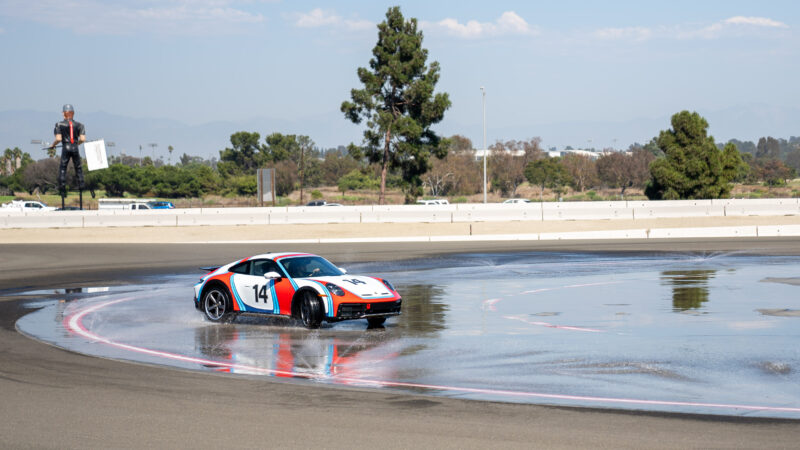
The skidpad and the most challenging part of the experience came next. With sprinklers raining on the surface, the giant donut-shaped course was ready for slides. I, however, was not. As I picked up speed on the course, my foot slowly came off the throttle while I tucked the nose towards the center of the track. I floored it and counter-steered to catch the slide. I did it precisely as I’ve done in countless rear-drive BMW M cars and as I did on an ice track with rear-drive V8 Maseratis. What I hadn’t done is remember that the Dakar is all-wheel drive.
Initiating proved easy enough; however, holding it was much more challenging. The Porsche 911 Dakar can hold extreme angles as it glides across a track sideways. It requires more throttle than steering input, and once in the drift, total commitment to the throttle to keep it going. Even as you feel you’re a split second away from looping it, it demands a steady feed of power. Grant its wish, and you’ll be rewarded with controllable drifts that don’t end with you facing backward. All it takes is a bit of mental rewiring.
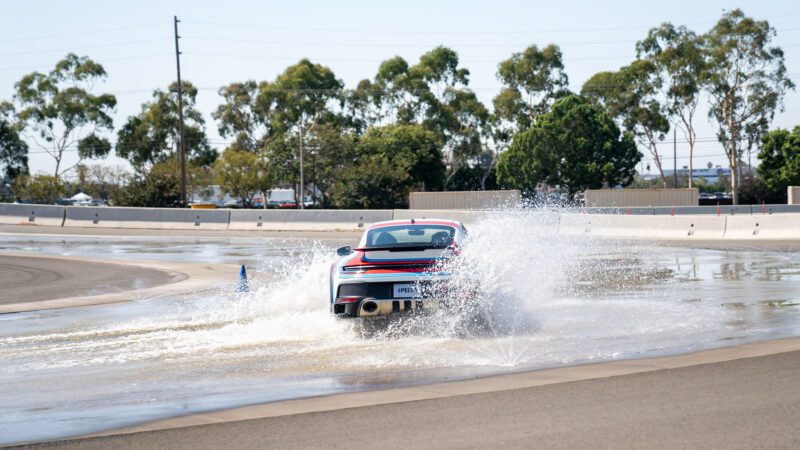
Before we pulled onto the 1.3-mile circuit, my instructor directed me to a short autocross course to familiarize myself with the Dakar’s performance on a dry surface. Within minutes, however, it was time for some citing laps.
The track experience kicks off from the right seat as the instructor gives you a tour of the track, pointing out braking zones and demonstrating the ideal racing line. Now, you also become aware of the many other cars you share the circuit with. As you pull out of a corner, you may see a GT4 RS creeping up from behind or catch up to a Carrera S on a cool-down lap. There’s more to the experience than just the track itself, and the instructor is constantly monitoring traffic to ensure everyone keeps their distance and passes only on designated zones.
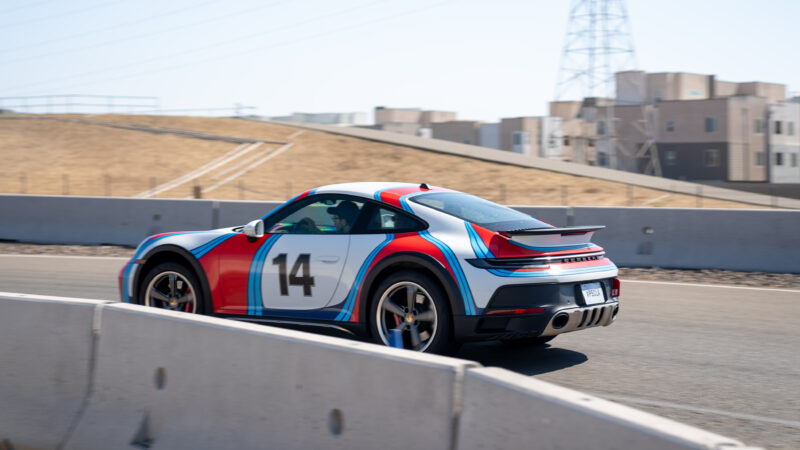
Back in the carbon buckets, I finally felt like I was getting to grips with the Dakar. Although much of it feels familiar with its cabin, GT sports wheel, and excellent visibility, some differences immediately emerge. For one, its stance. The Porsche 911 Dakar sits 1.9 inches taller than a Carrera equipped with a sports suspension. A standard lift system raises it a further 1.2 inches, a stature it maintains until you cross 105 mph.
Its hood, a gift from the GT3, and rear spoiler are carbon-fiber-reinforced plastic. A combo of lightweight glass and a lighter battery keeps its weight at 3,552 pounds. That’s 16 lb heavier than a 911 Carrera 4 GTS equipped with a PDK transmission. Yet despite weighing roughly the same, the Dakar sports additional underbody protection and a redesigned intake system.
The oily bits carry over from the Carrera 4 GTS largely untouched, with its twin-turbocharged 3.0-liter flat-six developing the same 473 horsepower and 420 pound-feet of torque output. It’ll sprint to 60 mph in 3.2 seconds and top out at 149 mph, with power going to all four wheels via an eight-speed PDK.
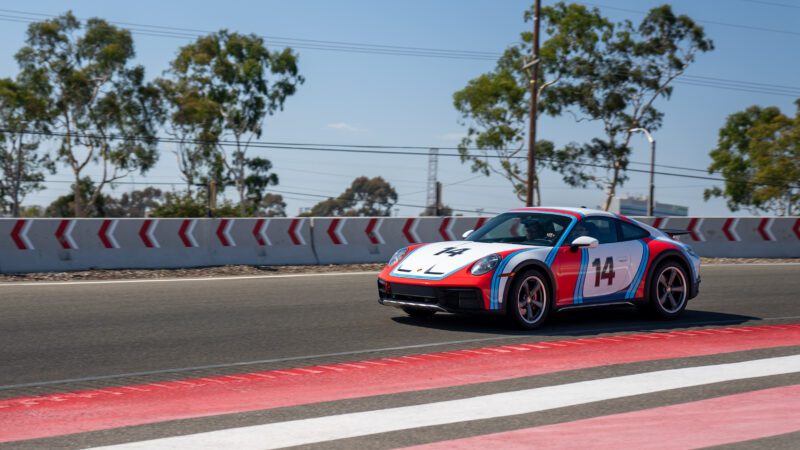
Picking up the pace as I learned the 1.3-mile track, I felt myself settling nicely into a rhythm behind the wheel. This may come as a shock, but equipped with summer tires, the Dakar drives like, well, a 911. Despite the lift, its handling is confident, and thanks to the Pirelli rubber, it delivers the grip you’d expect from a Carrera 4 GTS. I’d love to tell you that it leaned in the bends or felt drastically different, but that wasn’t the case. Even under hard braking zones, the nose never dipped considerably, nor did the back squat while shooting out the other side.
As anti-climatic as this revelation is, that also seems to be the Dakar’s secret sauce. Although Porsche developed it with off-roading in mind, I can’t help but remember the places where these cars actually live. Building a compelling off-roader is one thing, but its appeal would be limited if it only excels in that setting.
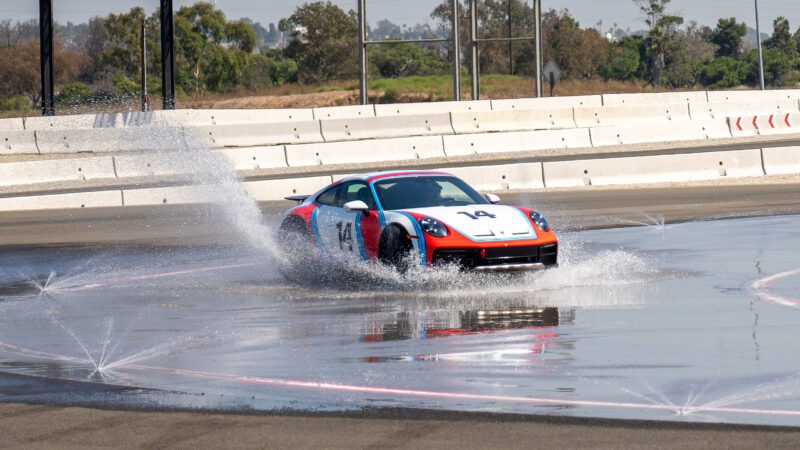
Yet that makes Dakar unique; it doesn’t ask you to choose. You can have the benefits of added ground clearance, a great ride, and the cool factor that is its unique aesthetic without sacrificing anything. Whether you go off-roading or, for whatever reason, you decide to take it to a track, it’s still as versatile as a 911 should be.
Tags: Featured
Related Articles

Review: 2025 Mercedes-Benz GLS 580 4Matic
Eating Up Monotonous Miles The drive from Milwaukee to St….
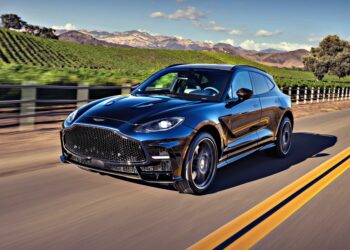
2026 Aston Martin DBX S First Drive: The Best Super SUV Gets Even Better
Model year 2026 marks the return of S variants to…
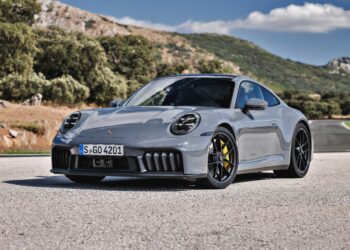
Review: 2025 Porsche 911 Carrera GTS T-Hybrid Electrifies Potent Performance
Picking through the menus of the infotainment screen and digital…
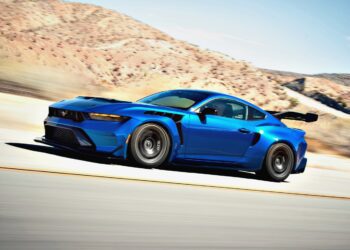
First Drive: Six-figure Ford Mustang GTD Boasts Peak Pony Muscle
If you thi
Review: The 2024 Ferrari Purosangue
by Gabriel Vega
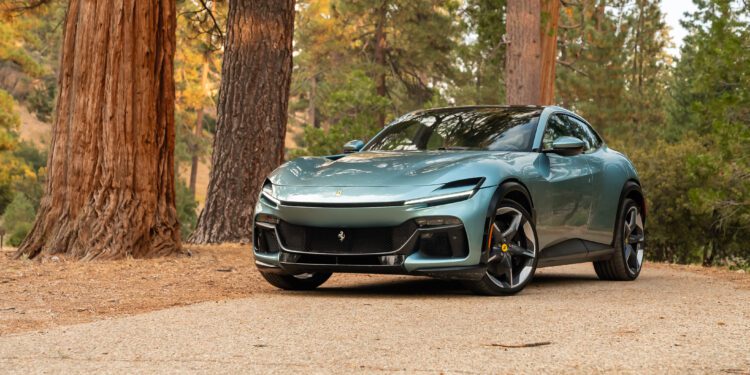
Building a super SUV has shifted from an if to a when for most performance brands. Back-to-back years of soaring sales have proven the concept’s viability and quickly made them integral to a low-volume manufacturer’s survival.
However, because the space is so lucrative, brands seem reluctant to experiment beyond the proven formula. Regardless of which badge adorns the nose, you’ll likely encounter similar layout, powertrain, and suspension configurations, often resulting in familiar driving experiences. This leaves the most distinguishing features to the styling and interior departments.
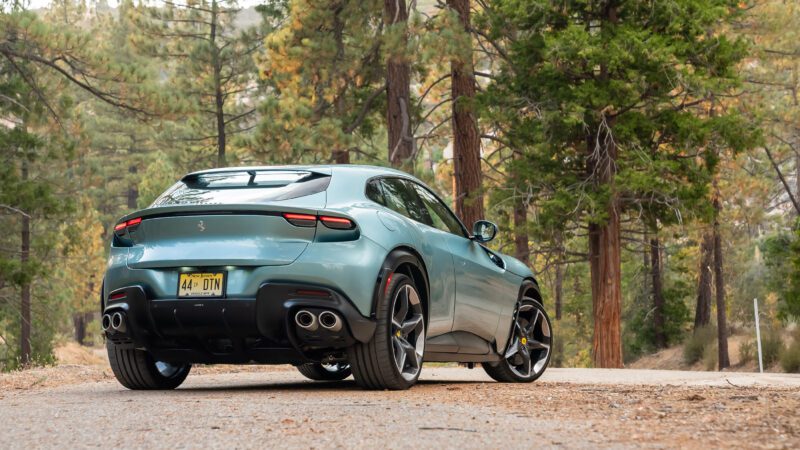
The 2024 Ferrari Purosangue takes a different approach. It rides on an all-new platform built just for it, adopting a front-mid engine layout. It employs a dual-clutch transaxle in the rear for better weight distribution, all-wheel drive, and all-wheel steering. However, its defining feature is the naturally aspirated 6.5-liter V12 nestled beneath its front-hinged hood. The $393,350 Purosangue is a Ferrari, a super SUV second, and the first to truly feel like an exotic machine. By venturing beyond the proven formula, Maranello’s first take on the type defines the segment.
Its name translates to “thoroughbred,” and in the Ferrari Purosangue’s case, it’s more than just a clever marketing ploy. Parts sharing is common in the space, ranging from engines to complete structures, but Maranello developed its first SUV by borrowing only from itself. Despite being larger than the GTC4Lusso’s, its bespoke aluminum chassis is lighter and 30 percent more torsionally rigid. This structure allowed Ferrari to employ a front-hinged hood à la Monza SP1 and a steeply raked A-pillar. A set of rear-hinged doors complement a traditional front pair and provide easy access to the cabin while keeping the Purosangue’s footprint as small as possible. A standard carbon fiber roof with built-in soundproofing is 20 percent lighter than an aluminum panel and lowers its center of gravity.
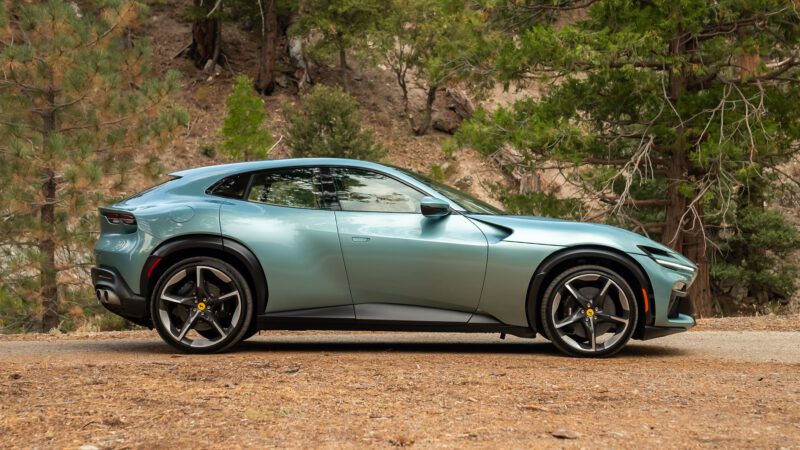
Its homebred bones create a distinct stance and presence. While the Ferrari Purosangue is as wide as a Lamborghini Urus, it’s six inches shorter and two inches lower thanks to its sloped roofline. As such, this Prancing Horse doesn’t immediately come across as a tall SUV; it’s more of a lifted GT, if anything, or the world’s brawniest hatchback. Its cabin also sits closer to the rear axle allowing it to sport a long hood design reminiscent of Maranello’s V12 two-door grand tourers. Stylistically, Ferrari’s choice to forgo a traditional headlight in favor of air intakes adorned with an LED strip, the use of floating wheel arches and rear hatch mounted spoiler only adds to its uniqueness. The Purosangue is equal parts eccentric and functional, and this blend suits it well.
Setting off in the Purosangue for the first time feels, above all else, familiar. You grip a flat-bottomed wheel straight out of a 296 GTB and glance at the digital instrument cluster introduced in the SF90 Stradale. Its engine note conjures up memories of the 812 Superfast, fitting since it employs the racier Competizione’s heads. This SUV is a Ferrari first, and there’s never a moment where it allows you to forget.
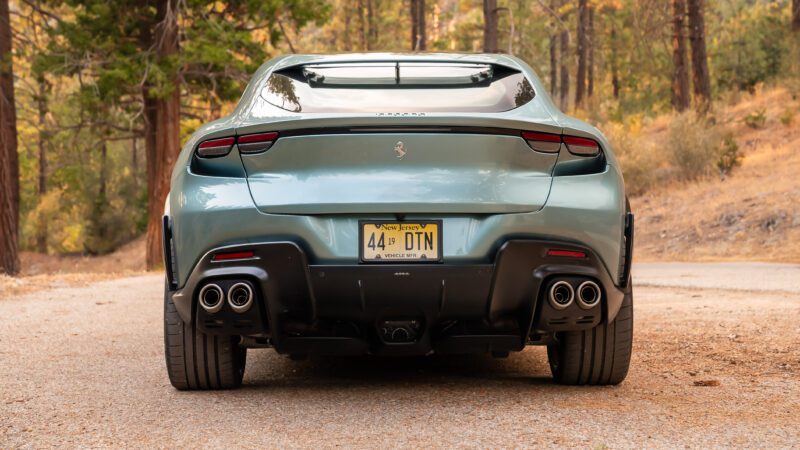
Lean into the throttle, and the feeling only intensifies. Its quad pipes come alive with a note whose pitch rises as you work your way up the tach. The Ferrari Purosangue develops plenty of power, but it makes you work for it. Its 6.5-liter V12 produces a massive 715 horses and 528 pound-feet, and until the recent introduction of the hybrid Lamborghini Urus SE, that made it the most powerful SUV in the segment. However, the Purosangue doesn’t lean on electrification or forced induction. With peak power coming in at 7,750 rpm, just shy of its 8,250 rpm redline, it has to be driven like a supercar to extract its very best. Yet despite these high peak power stats, its 6,250 rpm peak torque figure provides an excellent mid-range shove.
On a twisty road, the Purosangue rewards a slow-in, fast-out approach, with its dual-clutch transaxle ripping upshifts instantly as you rocket out of a bend. Speeds one through seven, a closely spaced set, carry over from the 296 GTB and the SF90 Stradale, while the top eight is longer for cruising on the highway. More importantly, its short gears effectively keep you within the power band while the instantaneous throttle response of its NA V12 allows it to feel every bit as quick as its 715-hp output would suggest. Flat out, you’ll hit 62 mph in 3.3 seconds and 124 in 10.6, maxing out at 193 mph.
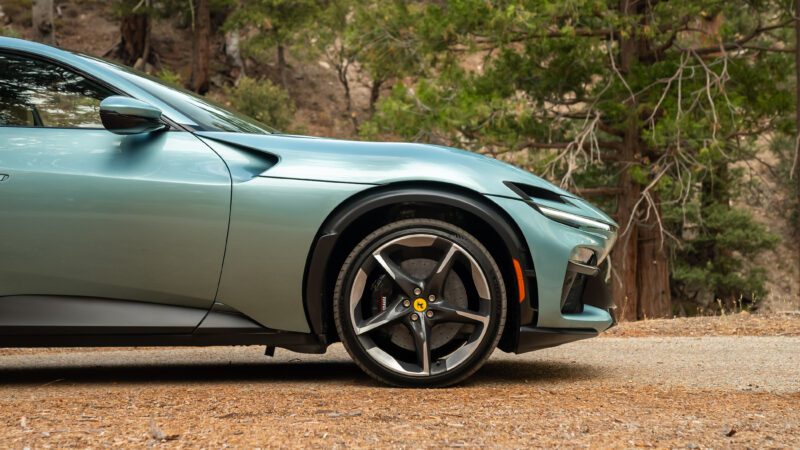
Dive into a corner, and the Ferrari Purosangue again rewards you with a familiar response. Like the 296 GTB, its steering is ultra-light, precise and quick. The subtlest call from the wheel gets a response from the front end. With a dry weight approaching 4,400 pounds, the Purosangue weighs less than the Lamborghini Urus and the Aston Martin DBX707. And despite housing a massive engine behind its front axle, it manages a 49:51 percent weight distribution. As such, you don’t feel a great big mass pushing forward as you begin to turn the wheel. Everything moves in unison.
However, there’s more at play than good weight distribution and sticky Michelin rubber. Developed in collaboration with Multimatic, the Purosangue’s active suspension incorporates True Active Spool Valve dampers, arguably the secret to its success. Each corner is paired with a 48-volt electric motor, and thanks to data fed to them by a myriad of sensors, each damper can respond independently, adjusting ride height and stiffness. During a launch or a heavy braking event, for example, the Purosangue squats to lower its center of gravity thus improving grip.
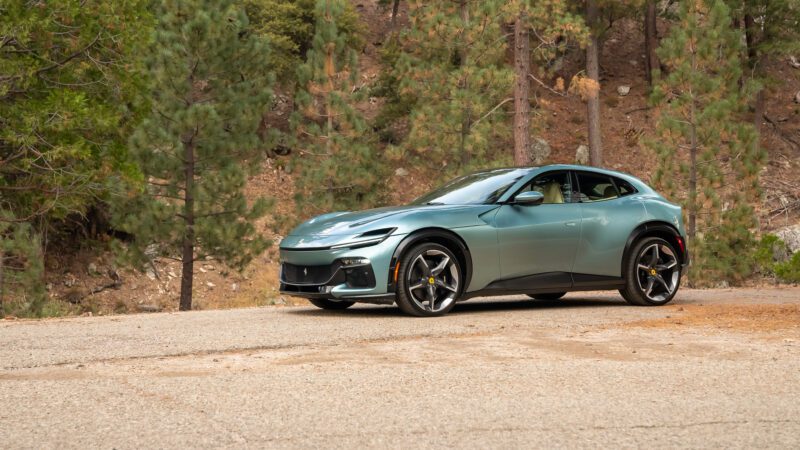
This system works in tandem with an all-wheel drive and steering system, which are fed braking, throttle, and steering input data and adjust accordingly. The Purosnague doesn’t just have pre-set drive modes. It’s actively responding to both you and the road ahead, dialing in the experience and allowing you to hustle up a mountain road with supercar pace.
Its suspension pays dividends around town and on the highway as well. By independently adjusting each corner, it’ll absorb bumps without leaning on an overly plush ride. The Purosangue thus feels settled but never firm, striking a nice balance for a machine meant for daily use. It is a super SUV in the truest sense.
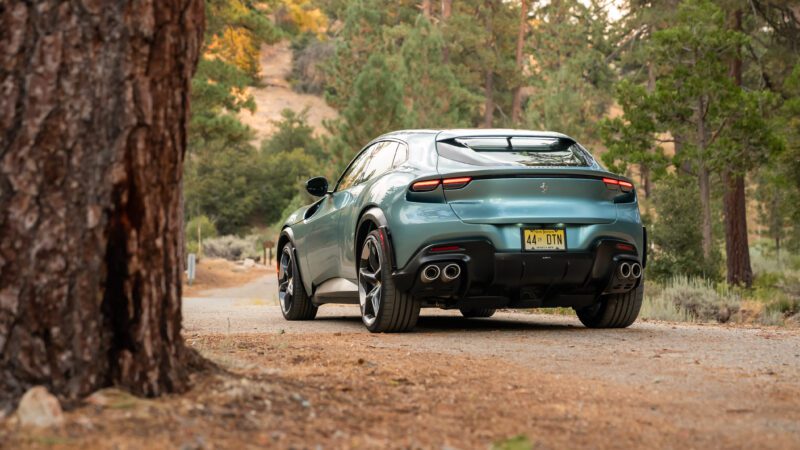
Yet, as proficient as the Ferrari Purosangue is in all things super, leaning so heavily into this persona requires some concessions. Recall its godly, high-revving V12 for a moment. It develops most of its power and torque at higher revs, and although Ferrari claims it’ll produce 80 percent of its torque output at 2,100 rpm, it doesn’t feel as quick as its rivals accelerating at lower speeds. You’ll still have to get deep into the tach to get going.
Its GT-style proportions might make it a stunner, but the Purosangue’s short rear end limits its cargo capacity to 16.7 cubic feet. For context, that’s slightly less than a Porsche Macan.
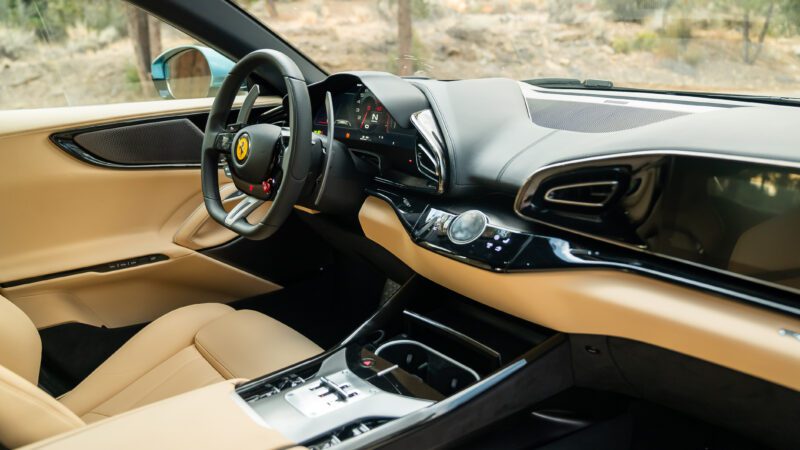
Step inside, and the Ferrari Purosangue greets you with a cabin that’s sporty but effortlessly elegant and arguably the best in the segment from a design point of view. Like the GTC4Lusso, there’s seating for four, with each leather-wrapped chair curving around you almost like the mild bucket seat. Upfront, a sizeable dual-screen layout splits the dash, with each display angles toward the driver and passenger respectively.
However, as gorgeous as this interior is, it’s clear that function follows form. In the center of the dash, you’ll find a small touchscreen with a rotating bezel, which, despite its footprint, controls multiple vital interior functions, often requiring you to swipe between minute menus. Operating it at speed feels like signing something while tying your shoe, and the steering wheel’s haptic feedback buttons require nearly as much attention. Thankfully, if someone is riding shotgun, many of these settings can be adjusted via the passenger display.
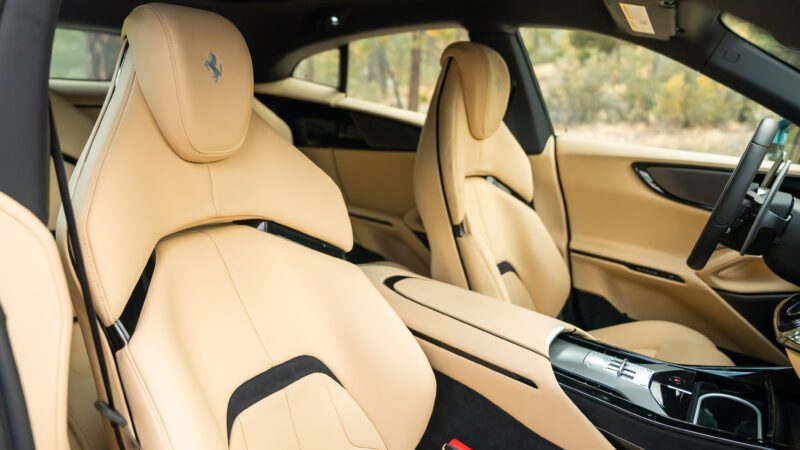
Pricing for the 2024 Ferrari Purosangue starts at $393,350, while this tester bumps that figure up to $506,305 with optional extras included. However, unlike the rest of the super SUV space, Maranello isn’t looking to sell as many as possible, capping its production at fewer than 3,000 units annually, or less than 20 percent of its total output. It was never meant as a volume play, and it’s all the better for it.
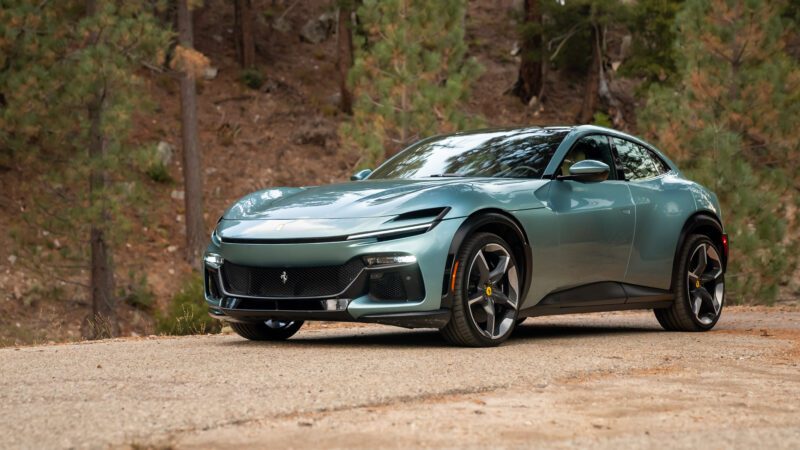
The Ferrari Purosangue may be one of the later entrants to the segment, but it distinguishes itself by doing things differently. It doesn’t follow established formulas, from engine layout to cylinder count and bespoke platform. Yet, by straying further and incorporating a revolutionary active suspension system from the wizards at Multimatic, it blends its excellent straight-line performance and characterful V12 with handling that’s befitting of a Prancing Horse.
From big and small details, the Purosangue feels like a Ferrari first and an SUV second. It’s arguably the first super SUV that feels like a proper exotic. And while achieving this persona requires some concessions, they don’t detract from what makes Maranello’s first take on the type so special. The Purosangue isn’t just another super SUV. It defines the segment.
Tags: Featured



